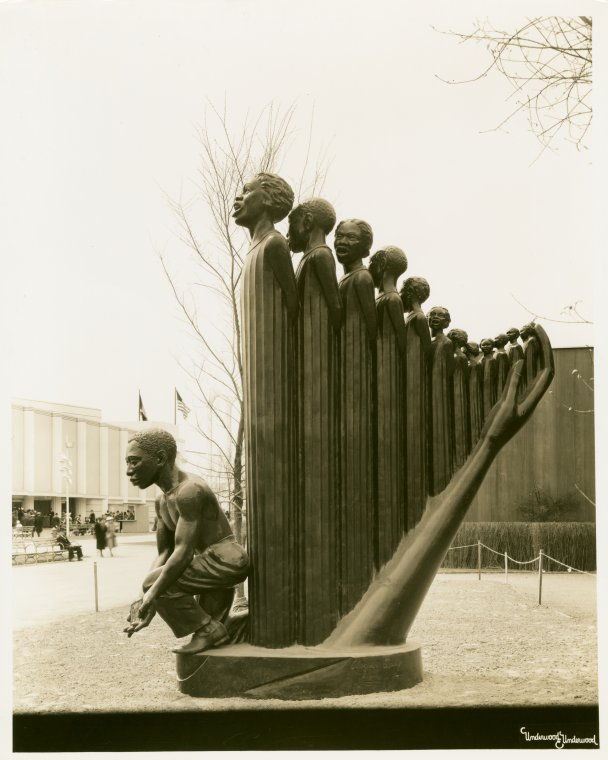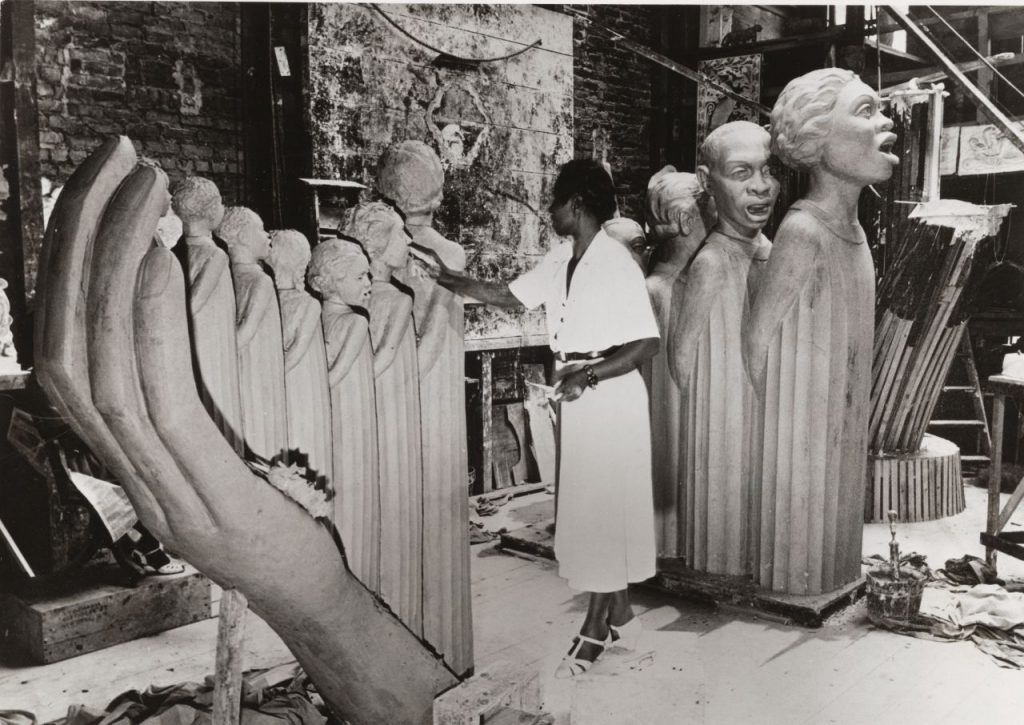Background
The Harlem Renaissance was not limited to the 1920s. African American artists, writers, and activists like Zora Neale Hurston continued to produce inspiring and thought-provoking work through the challenges of the Great Depression. The sculptor Augusta Savage was one of many Harlem Renaissance artists who maintained her career through the support of New Deal policies. Thanks to Works Progress Administration (WPA) funding, Augusta taught free art classes to local Harlem residents. Many of her students would go on to have world-renowned careers, including Jacob Lawrence.
In 1939, Augusta was one of twelve women artists commissioned to create a work of art for the 1939 World’s Fair in New York City. She was the only Black woman in the group. Augusta knew that her sculptures would literally sit on a world stage for the run of the fair. Most of her career focused on creating pieces that advocated for equal rights and the empowerment of the Black community. She embraced her belief in art as a form of activism and created a piece called The Harp. Nearly 44 million people attended the 1939 World’s Fair, and many of them viewed The Harp during their visit.
About the Image
The Harp was a sixteen-foot-tall sculpture honoring Black contributions to music and the resiliency of the Black community. It references the African American hymn “Lift Every Voice and Sing,” which is often called the Black national anthem. Augusta created the shape of a harp using the forms of twelve singing Black children in increasing size. A large arm—perhaps the arm of God—serves as the harp’s base. At the front, a young man holds a plaque with lines from the popular song.
Augusta often cast her sculptures in bronze. However, funding for the 1939 World’s Fair was limited and bronze was expensive. The final piece was cast in plaster. Like many works of art at the world’s fair, it was destroyed when the fair ended. Today, it only exists in photographs and small souvenir replicas.
Vocabulary
- commissioned: Invited and paid to create or make something for a specific purpose or audience.
- Jacob Lawrence: Twentieth-century African American painter famous portraying Black life in America. An active participant in the Harlem Renaissance who was influenced by twentieth-century Cubism paintings.
- New Deal: President Franklin Delano Roosevelt’s national program for stimulating the American economy during the Great Depression. Included employment, housing, and social service support systems.
- sculptor: An artist who creates sculptures.
- sculpture: A three-dimensional work of art, typically carved or molded.
- Works Progress Administration (WPA): A program under the New Deal that employed approximately 8.5 million men and women in a variety of jobs.
- world’s fair: An exhibition that included the participation of artists, scientists, businesses, and nations from across the globe.
Discussion Questions
- Analyze the image of the sculpture. What details do you notice? What are the different parts of the piece?
- Analyze the image of Augusta Savage working in her studio. How does this image enhance your understanding of this sculpture?
- Why was it significant that the 1939 World’s Fair commissioned Augusta Savage?
- Why do you think Augusta Savage chose to dedicate her world’s fair piece to Black music and specifically “Life Every Voice and Sing”? What was she trying to tell visitors to the fair?
- How would you describe Augusta Savage’s art? Why might some consider it a form of activism? Do you agree?
Suggested Activities
- Lesson Plan: In this lesson designed for fourth grade, students will learn about Augusta Savage and her sculptures.
- Connect Augusta Savage to the wider narrative of the Harlem Renaissance by pairing these images with the life stories of Zora Neale Hurston and Pauli Murray.
- Provide students with the lyrics to “Lift Every Voice and Sing” and, if possible, play a recording of the song. Ask students to discuss how the song and the sculpture relate. Why did Augusta Savage choose this song as her inspiration? Now that you know the lyrics, how does that enhance your understanding of what she was trying to say?
- Augusta Savage taught many famous artists of the Harlem Renaissance, including Jacob Lawrence. Learn more about him, his art, and his service in World War II in the New-York Historical Society’s WWII & NYC curriculum guide. Compare his visual depiction of Black life during the war with Augusta’s sculpture.
- Augusta Savage was not the only artist inspired by “Lift Every Voice and Sing.” Encourage students to do their own research into the history of the song and its use by performing and visual artists. A recent example includes Beyonce’s 2018 Coachella performance.
- Have students consider Augusta Savage’s inspiration for The Harp by creating their own sculpture in response to a piece of music that has personal significance for them in this arts integration activity.
Themes
AMERICAN CULTURE; ACTIVISM AND SOCIAL CHANGE








